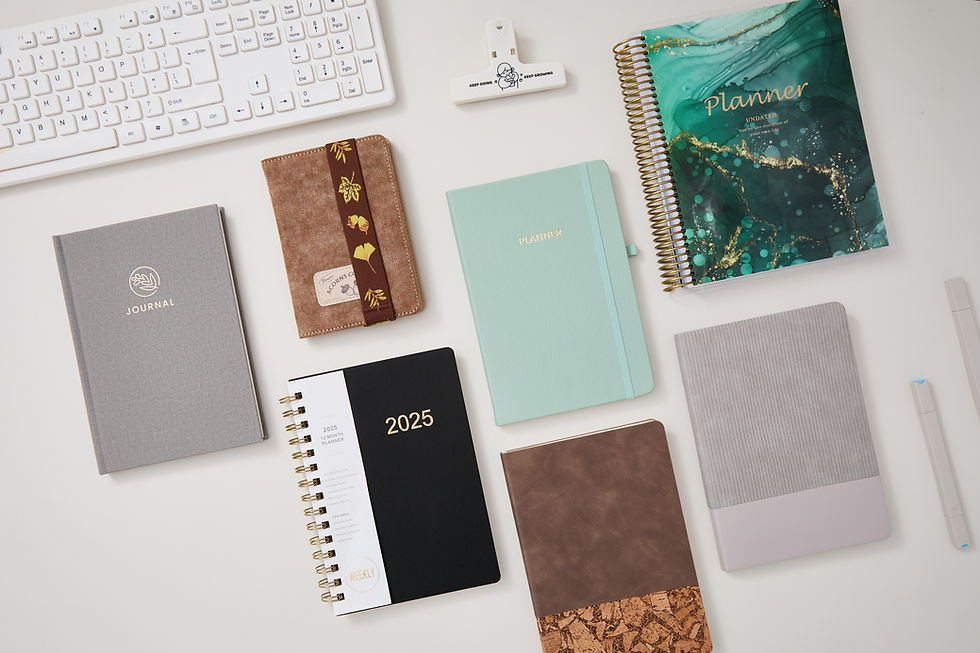Select the Perfect Materials for Your Custom Notebooks
- Lion Paper Team

- Mar 24
- 3 min read
Updated: Mar 26
Pre Reading: Did you know that 73% of consumers will pay a premium for sustainable products? When it comes to custom notebooks, your material choices do more than shape functionality—they narrate your brand's story, sustainability commitment, and dedication to quality. Here's how Lion Paper has helped leading brands harness the power of material selection to captivate customers and drive market success.
Choosing the right materials for custom notebooks is crucial. The choices you make can greatly affect durability, user experience, and overall appeal. In today's market, particularly in the U.S., material selection impacts not only product performance but also brand perception, sustainability, and consumer preference. This guide, enriched with insights from Lion Paper's experience, will help you make informed decisions when selecting materials, enabling your notebooks to resonate deeply with your audience and sustainability goals.
The materials used in custom notebooks create a powerful impression. From the weight and texture of the paper to the cover's finish and binding methods, each choice sends a message about quality and functionality. Let’s explore key factors to consider, illustrated with successful examples from Lion Paper's collaborations with global brands.
1. Choosing the Right Paper for custom notebooks

The choice of paper fundamentally shapes the notebook's user experience.
Lion Paper Example: For a high-end U.S. stationery brand seeking a luxurious, fountain pen-friendly experience, Lion Paper recommended a premium 160 gsm cream paper, significantly reducing bleed-through and enhancing readability.
Essentials to Consider:
Weight and Thickness (gsm): Ideal papers for everyday use range from 100-120 gsm. Heavier papers like 160 gsm are preferable for high-end writing instruments.
Texture and Writing Experience: Satin finishes offer smooth writing, whereas laid finishes provide tactile experiences perfect for sketching.
Ink Absorption and Drying Speed: Fast-drying paper prevents smudging, ideal for gel or fountain pens.
Types of Paper:
Standard (uncoated)
Recycled and Eco-Friendly (up to 30% reduced environmental impact)
Premium Papers (cream, fountain pen-friendly)
2. Cover Materials for Impact and Durability

Covers shape first impressions and brand perceptions.
Lion Paper Example: Lion Paper assisted an eco-conscious lifestyle brand by providing vegan leather covers made from recycled materials, significantly enhancing their market appeal among environmentally-focused consumers.
Material Options:
Leather and Vegan Leather: Luxury and ethical alternatives.
Soft-Touch Laminated Paper: Smooth, high-end aesthetics.
Linen or Fabric Covers: Premium, tactile options.
Kraft and Recycled Cardboard Covers: Eco-conscious and rustic appeal...
3. Binding Methods and Their Material Considerations

The binding method influences notebook longevity and usability.
Lion Paper Example: For an artist-focused client, Lion Paper used spiral binding, allowing notebooks to lay flat for effortless sketching and note-taking.
Spiral/Coil Binding: Ideal for flexible use.
Perfect Binding: Cost-effective, suitable for general usage.
Sewn Binding: Superior durability, ideal for intensive usage.
4. Sustainable and Eco-Friendly Materials
Eco-conscious materials attract today's environmentally-aware consumers.
Lion Paper Example: Lion Paper successfully implemented FSC-certified paper combined with biodegradable inks for a major retail brand's planner line, effectively capturing consumer attention by aligning with their sustainability commitments.
Popular Eco-Friendly Materials:
Bamboo and Cork Covers: Renewable, natural aesthetics.
Recycled Paper: Reduces waste, offers unique appeal.
FSC-Certified Paper: Assures responsible sourcing.
Biodegradable Inks and Adhesives: Enhances overall eco-friendliness.
5. Customization and Branding Options
Customization differentiates your products in the market.
Lion Paper Example: Lion Paper collaborated with a sleek tech startup to produce notebooks with minimalist, soft-touch laminated covers featuring sophisticated foil stamping, perfectly reflecting their modern brand identity.
Material Considerations for Custom Features: Leather for debossing; coated papers ideal for foil stamping.
Highlight Brand Features: Natural fibers suit rugged brands; smooth, minimalist materials match tech-forward companies.
Closing Thoughts on Material Selection
Selecting the right materials enhances the notebook's functionality, durability, and appeal. As demonstrated through Lion Paper's successful client cases, carefully choosing paper, covers, binding methods, and sustainability factors allows your products to communicate brand values and satisfy consumer demands.
Final Tips:
Prioritize audience preferences.
Test materials for the ideal balance of quality and cost.
Stay updated on new sustainable materials to remain competitive.
Thoughtful material selection can elevate your notebooks from ordinary stationery to powerful branding tools that speak volumes about your commitment to quality and sustainability.
Leo Xia
CEO, Lion Paper Products
“You design, we deliver.”






Comments